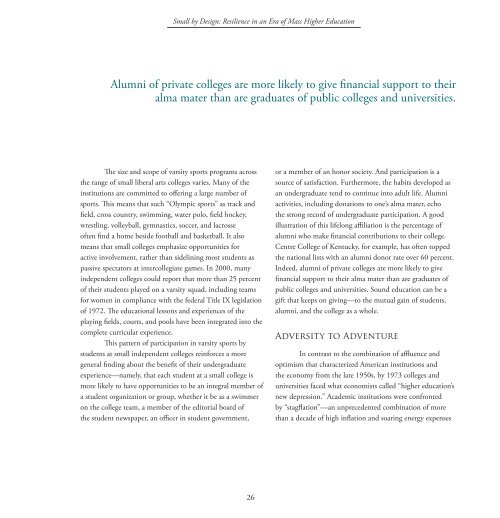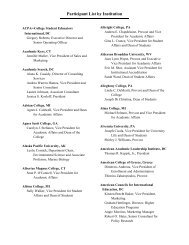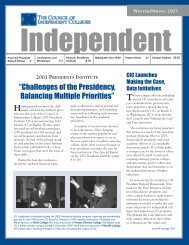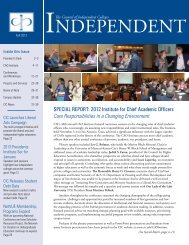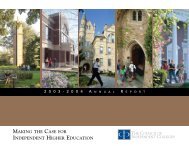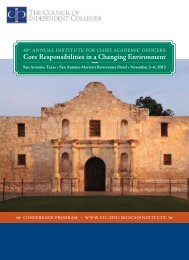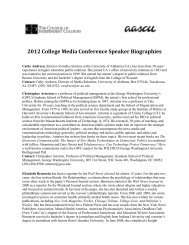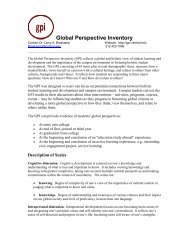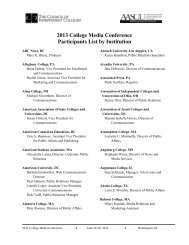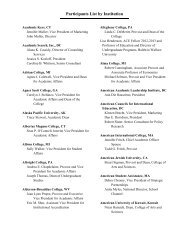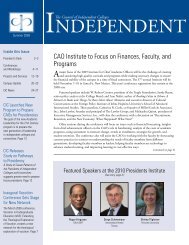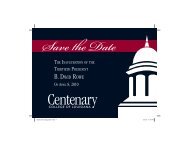Meeting the Challenge: - The Council of Independent Colleges
Meeting the Challenge: - The Council of Independent Colleges
Meeting the Challenge: - The Council of Independent Colleges
Create successful ePaper yourself
Turn your PDF publications into a flip-book with our unique Google optimized e-Paper software.
Small by Design: Resilience in an Era <strong>of</strong> Mass Higher Education<br />
Alumni <strong>of</strong> private colleges are more likely to give financial support to <strong>the</strong>ir<br />
alma mater than are graduates <strong>of</strong> public colleges and universities.<br />
<strong>The</strong> size and scope <strong>of</strong> varsity sports programs across<br />
<strong>the</strong> range <strong>of</strong> small liberal arts colleges varies. Many <strong>of</strong> <strong>the</strong><br />
institutions are committed to <strong>of</strong>fering a large number <strong>of</strong><br />
sports. This means that such “Olympic sports” as track and<br />
field, cross country, swimming, water polo, field hockey,<br />
wrestling, volleyball, gymnastics, soccer, and lacrosse<br />
<strong>of</strong>ten find a home beside football and basketball. It also<br />
means that small colleges emphasize opportunities for<br />
active involvement, ra<strong>the</strong>r than sidelining most students as<br />
passive spectators at intercollegiate games. In 2000, many<br />
independent colleges could report that more than 25 percent<br />
<strong>of</strong> <strong>the</strong>ir students played on a varsity squad, including teams<br />
for women in compliance with <strong>the</strong> federal Title IX legislation<br />
<strong>of</strong> 1972. <strong>The</strong> educational lessons and experiences <strong>of</strong> <strong>the</strong><br />
playing fields, courts, and pools have been integrated into <strong>the</strong><br />
complete curricular experience.<br />
This pattern <strong>of</strong> participation in varsity sports by<br />
students at small independent colleges reinforces a more<br />
general finding about <strong>the</strong> benefit <strong>of</strong> <strong>the</strong>ir undergraduate<br />
experience—namely, that each student at a small college is<br />
more likely to have opportunities to be an integral member <strong>of</strong><br />
a student organization or group, whe<strong>the</strong>r it be as a swimmer<br />
on <strong>the</strong> college team, a member <strong>of</strong> <strong>the</strong> editorial board <strong>of</strong><br />
<strong>the</strong> student newspaper, an <strong>of</strong>ficer in student government,<br />
or a member <strong>of</strong> an honor society. And participation is a<br />
source <strong>of</strong> satisfaction. Fur<strong>the</strong>rmore, <strong>the</strong> habits developed as<br />
an undergraduate tend to continue into adult life. Alumni<br />
activities, including donations to one’s alma mater, echo<br />
<strong>the</strong> strong record <strong>of</strong> undergraduate participation. A good<br />
illustration <strong>of</strong> this lifelong affiliation is <strong>the</strong> percentage <strong>of</strong><br />
alumni who make financial contributions to <strong>the</strong>ir college.<br />
Centre College <strong>of</strong> Kentucky, for example, has <strong>of</strong>ten topped<br />
<strong>the</strong> national lists with an alumni donor rate over 60 percent.<br />
Indeed, alumni <strong>of</strong> private colleges are more likely to give<br />
financial support to <strong>the</strong>ir alma mater than are graduates <strong>of</strong><br />
public colleges and universities. Sound education can be a<br />
gift that keeps on giving—to <strong>the</strong> mutual gain <strong>of</strong> students,<br />
alumni, and <strong>the</strong> college as a whole.<br />
Adversity to Adventure<br />
In contrast to <strong>the</strong> combination <strong>of</strong> affluence and<br />
optimism that characterized American institutions and<br />
<strong>the</strong> economy from <strong>the</strong> late 1950s, by 1973 colleges and<br />
universities faced what economists called “higher education’s<br />
new depression.” Academic institutions were confronted<br />
by “stagflation”—an unprecedented combination <strong>of</strong> more<br />
than a decade <strong>of</strong> high inflation and soaring energy expenses<br />
26


